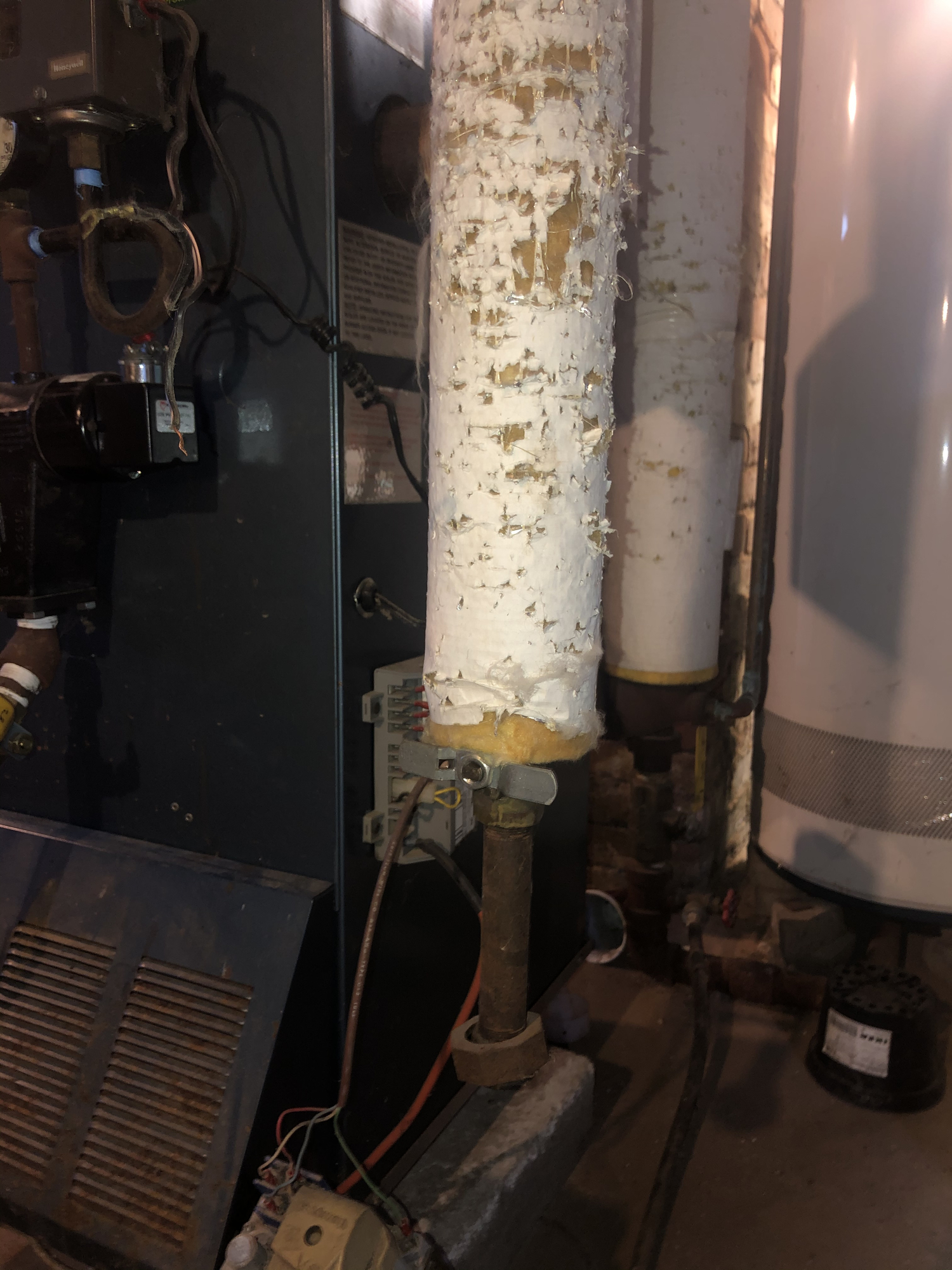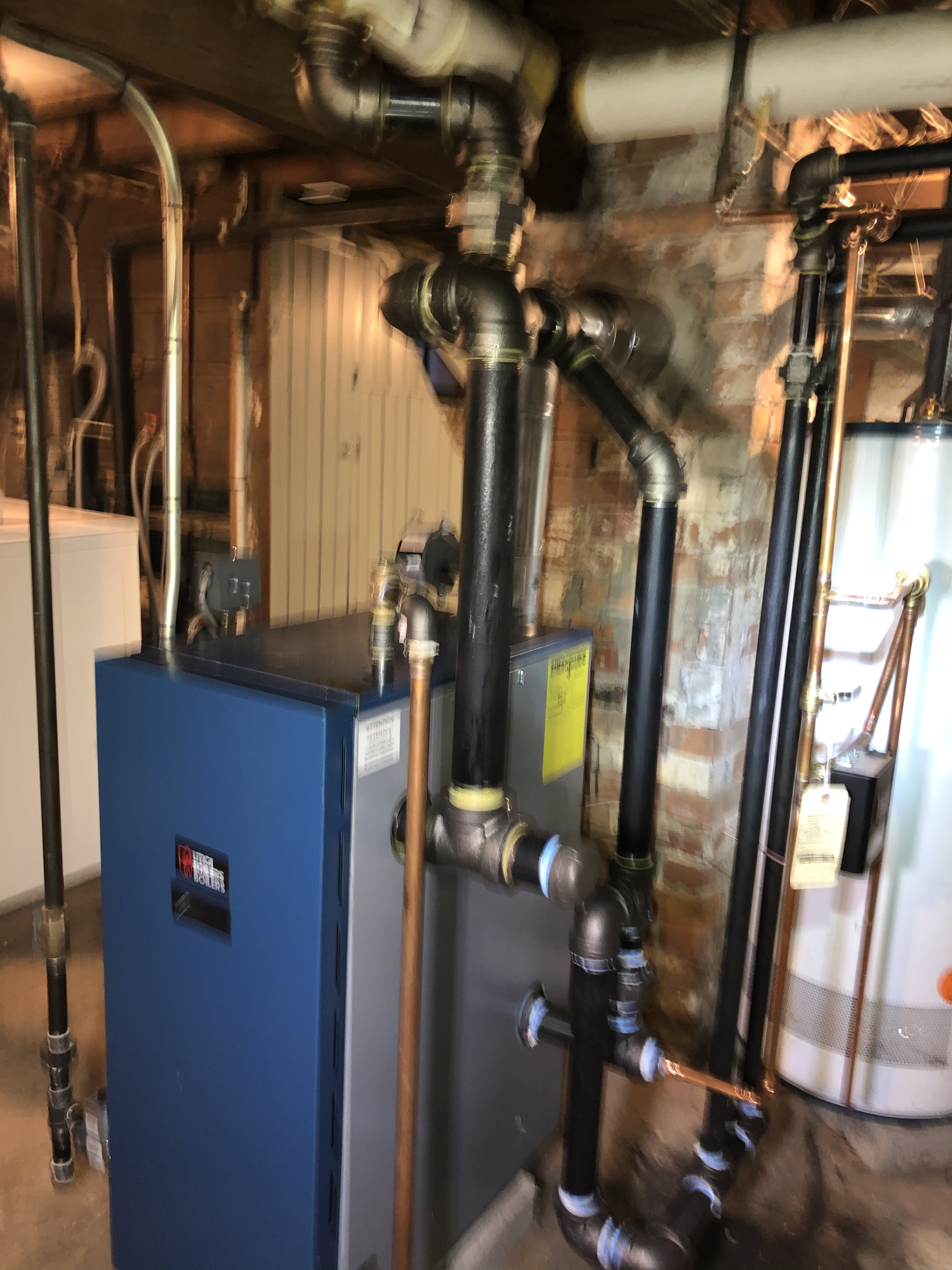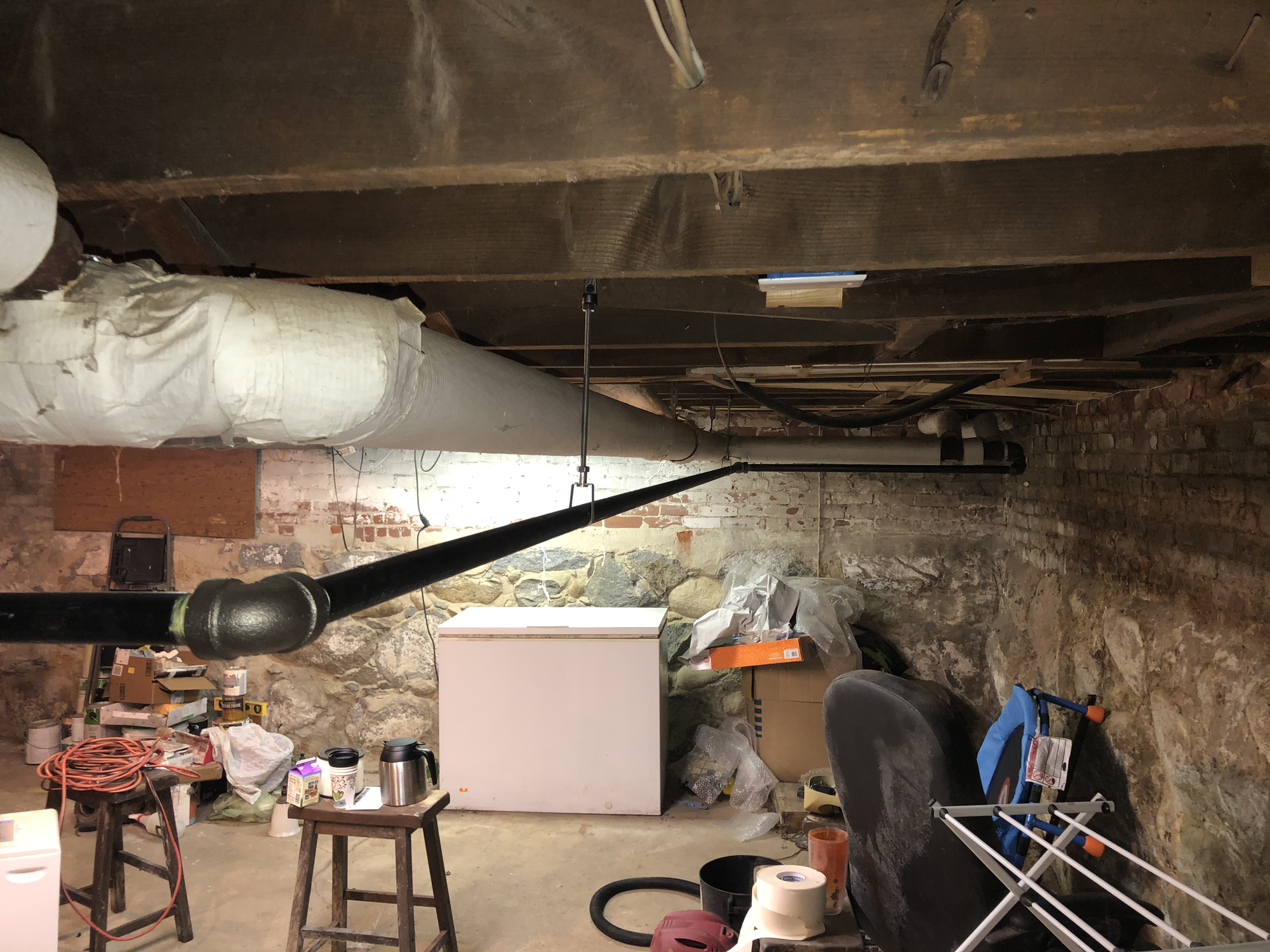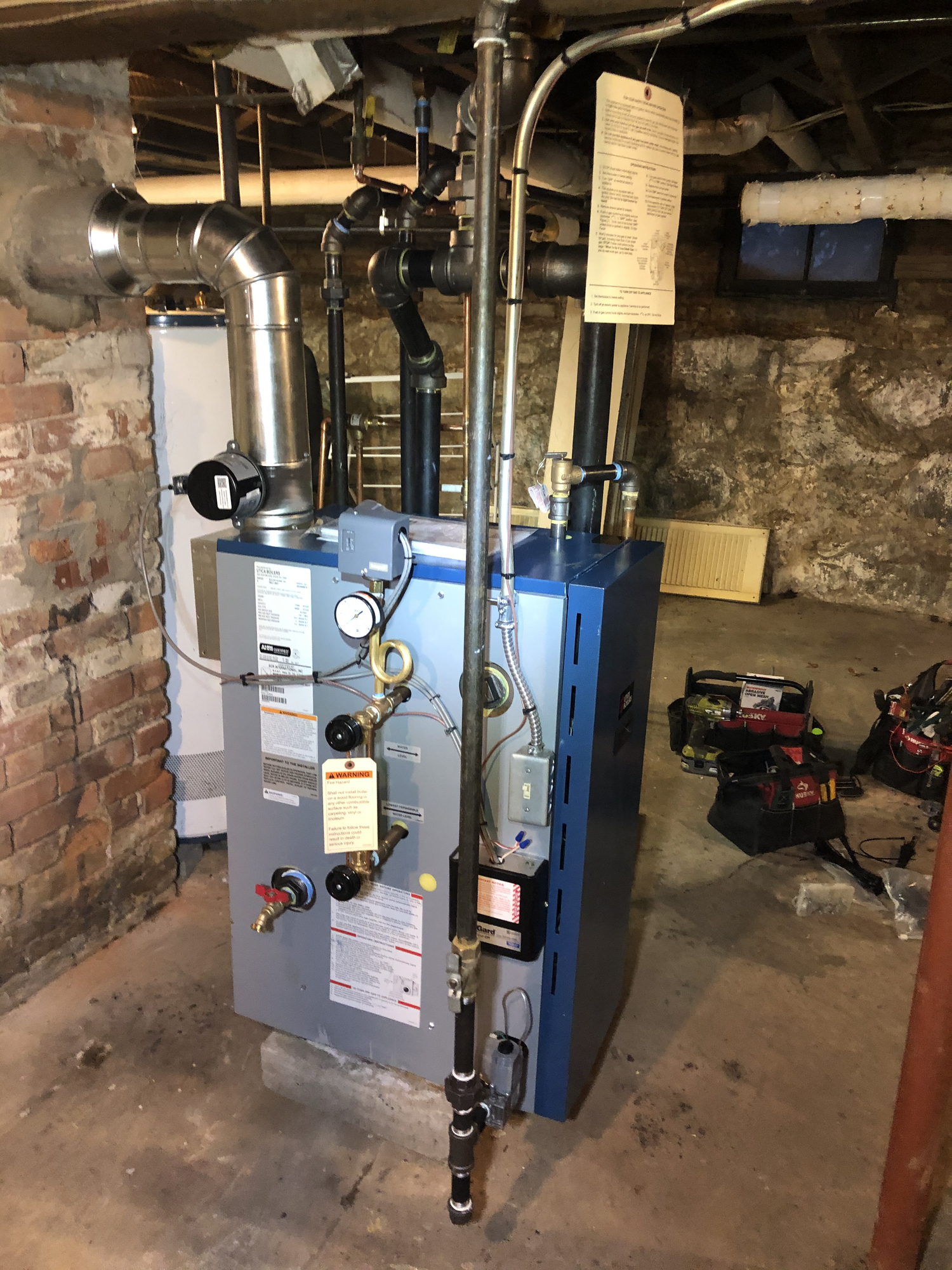First steamer in a couple years







The picture of the old insulated gas line is just a bonus.
Comments
-
-
-
I like it except not my favorite brand! Great job right-sizing it!
Did you consider to put a main vent here to keep steam from having to fill up the return trip?
Is there a valve on the nice short wet return to let the goop out?NJ Steam Homeowner.
Free NJ and remote steam advice: https://heatinghelp.com/find-a-contractor/detail/new-jersey-steam-help/
See my sight glass boiler videos: https://bit.ly/3sZW1el0 -
Paul well I'm not super thrilled with some other steam brands so I'll just stick to what works.
Vents, does it really matter if they are here or at the end, where i installed them? I'm so used to sticking them at the boiler---I figure the steam gets to the rads at the same speed regardless.
My main man taped/doped this then i yelled over, 'why tape it? Just yellow the thing"
Looks like my 32 year old Ridgid 300 still has a good bite.0 -
-
@ethicalpaul
It doesn't matter which end the vent is at. If you don't believe me install it where the steam main ends and with the boiler steaming try and hold your hand on the drop to the boiler above the water line. You will let go real quick. As the condensate rolls down the bottom of the pipe the air gets pushed to the top of the pipe it can't go down into the boiler so it works its way back to the vent. With most (but not all) of the air vented the steam will work it's way down to the end.0 -
It will work fine but I think it will take longer for steam to start getting pushed up to the radiators (provided the main venting is sufficient)
there must be 20 feet of main having to get heated and filled with steam before the main vent but after the last radiator takeoff.
Imagine it dropped to the floor there. You’d put the vent there. You can still put the vent there even though it doesn’t drop.
just something to consider, no biggie.NJ Steam Homeowner.
Free NJ and remote steam advice: https://heatinghelp.com/find-a-contractor/detail/new-jersey-steam-help/
See my sight glass boiler videos: https://bit.ly/3sZW1el0 -
@My570 I simply put the vents at the end because of tradition. I can’t possibly see how this slows anything down. In a hair splitting way, maybe the boiler would cycle off a little sooner had I put the vents in their original position, but how could the rads be full of steam if the 2” mains were “just filled”?@ethicalpaul see what you started 😀
@EBEBRATT-Ed thanks Ed they had me in a corner there for a moment.
@Jamie Hall well I’ll probably remain a finicky switch hitter, I’m only taking on steam stuff if it’s close to me (this job was 7 minute drive) and we’re not hammering on wet stuff and heat pump stuff. Thanks for considering we worthy1 -
For what it's worth, @GW (and @ethicalpaul ) , so long as the vent is on a steam main -- or a continuation of it heading back to the boiler -- it doesn't matter how far past the last takeoff it is so far as timing of getting heat to a radiator goes. Once the steam front -- if I may call it that -- in the main gets past a runout, that runout will start filing with steam. You don't have to fill the entire main with steam to do that. So placing the vents at the boiler, for example, in the type of system where the steam mains loop back around like that is just fine.Br. Jamie, osb
Building superintendent/caretaker, 7200 sq. ft. historic house museum with dependencies in New England0 -
Yes I stood there and thought about it when i first scoped out the job, my little voice said, 'how can it possibly matter'. Glad it passes with the super pros0
-
A 1 x 3/4 tee costs less than a 2 x 3/4 tee, that's my final answerethicalpaul said:You can still put the vent there even though it doesn’t drop.
just something to consider, no biggie. 1
1 -
@Jamie Hall I tend to agree about putting the main vent on the return near the boiler with one key point. In my system there are front and rear mains, the front being significantly longer (like 50%). At some point in time, the returns were piped such that they came together above the water line. The vents were connected to a common return less than a foot apart. I had trouble balancing the system for a bunch of reasons, but one day it dawned on me that the rear main was venting through its vent as well as interfering with the front main vent, because of the difference in the volume of the mains.
I repiped the returns to separate the returns by connecting the rear below the water line. That way the front and rear returns don't compete for the venting. What an improvement!!!
I also added a drain valve.
I can post before and after pics, if anyone is interested.1 -
I guess that's making sense. If the two returns were open to each other, then the shorter main would trump the longer one. Dunking them in them in the water makes it more normal and separated. I presume a short main will always heat faster than a long main, unless you start slowing down venting in the shortie.0
-
Sorry to disagree, but it absolutely does matter. The main vent will (or should!) steal almost all the airflow from the risers. That's why we vent the mains with such capacity (and such expensive vents as Gorton #2 and Big Mouth)...so that the entire main fills with steam before any of the radiators or their risers do.Jamie Hall said:For what it's worth, @GW (and @ethicalpaul ) , so long as the vent is on a steam main -- or a continuation of it heading back to the boiler -- it doesn't matter how far past the last takeoff it is so far as timing of getting heat to a radiator goes. Once the steam front -- if I may call it that -- in the main gets past a runout, that runout will start filing with steam. You don't have to fill the entire main with steam to do that. So placing the vents at the boiler, for example, in the type of system where the steam mains loop back around like that is just fine.
If you have insufficient main venting then yes, steam will start to go up the risers before the main is full of steam, and that leads to balancing problems.
PS: I like your term "steam front"!
PPS: @GW please do continue to do steam work in your area (sorry I don't know where that is). But wherever you are I know the people of that area would benefit from your work!! Edit: Oh you're in Northampton!! Haven't we heard that no one can find steam pros up there?? (I love it up there)NJ Steam Homeowner.
Free NJ and remote steam advice: https://heatinghelp.com/find-a-contractor/detail/new-jersey-steam-help/
See my sight glass boiler videos: https://bit.ly/3sZW1el1 -
I see your point, not sure 'how much' that matters though. I'll do vents on the big mains in the future
0 -
If you go back to skim again, time how long it takes for steam to get from the "turnaround" to the vent and multiply that times how many heating cycles per season, and that's how much time the steam could be heading to the radiators but mostly isn't. The customer will never notice though.
NJ Steam Homeowner.
Free NJ and remote steam advice: https://heatinghelp.com/find-a-contractor/detail/new-jersey-steam-help/
See my sight glass boiler videos: https://bit.ly/3sZW1el0 -
@ethicalpaul and @Jamie Hall There are three cases here.
1. One main vent located after the last riser.
2. One main vent on the return close to the boiler.
3. One main vent located after the last riser and a second main vent on the return close to the boiler.
Each case is slightly different. I am not sure I am smart enough to accurately explain the differences, based on my experience. Here's my guess.
Case 1. may vent the risers and radiators faster, because the return is not vented at all and no steam is used to vent it. I'm not sure this is a good practice.
Case 2. "steals" some steam to vent the return until the main vent shuts, taking more time to heat up the risers and radiators.
Case 3. provides more total venting, also stealing vent capability from the risers and radiators until it shuts.
Bottom line, it may make little difference to the risers and radiators if the steam production rate of the boiler is high enough...seconds to a couple of minutes at most, maybe.
What say you?
As an aside, in my system, I added a main vent to the longer main, and kept both on the returns close to the riser. Months later, when I made my "discovery", I repiped the returns to eliminate the rear main from using the front main vent, as mentioned above. I don't know how much effect the splitting up had.
Happy tenants, happy landlord.0 -
Since you asked

Case 1 is best. You don't waste fuel and time heating up then filling the "return" with steam at all (if some eventually gets there, whatever). Note that I put "return" in quotes because Jamie has made a strong argument in the past that "return" (and especially "dry return") is a misnomer. You'll see him call it "the part of the main that continues back to the boiler after the last radiator runout" or similar. I'm not opposed to his thinking although I do think that "dry return" is a good enough name for the part of the main that "returns" to the boiler after feeding its radiators, as this one does.
Case 2: Second best. It can be handy to have the main vent near the boiler since you don't have to walk to check to see if it's closing correctly. You can see everything happening from one vantage point. Especially useful like in this case with multiple mains.
Case 3: Not great. There's no advantage to this one that I can think of. If you want more total venting, put the two vents together just after the last runout (as many people do).NJ Steam Homeowner.
Free NJ and remote steam advice: https://heatinghelp.com/find-a-contractor/detail/new-jersey-steam-help/
See my sight glass boiler videos: https://bit.ly/3sZW1el0 -
@Jamie Hall Love the "steam front"
@GW A 1 x 3/4 tee costs less than a 2 x 3/4 tee, that's my final answer !! That my way of thinking
The thing is no one can prove that steam is not getting into the return that goes back to the boiler if the vent is installed at the end of the main versus at the end of the drop. Steam is going down that pipe regardless of the vent location. If the pipe was stuffed with air so steam wouldn't get down it the bottom of the pipe would be hot from condensate and the top with the trapped air would be a lower temp
@SteamingatMohawk
I installed a boiler in a library years ago. The steam came off the boiler went to the far end of the building and then split into 2 loops feeding the radiation and each main ended up back at the boiler. Problem is someone connected the end of the mains together above the water line.
Of course the steam went around 1 main faster and closed both vents. One loop wouldn't heat because all the trapped air had to get out through the radiator vents.
Changed all the radiator vents, connected the returns below the water line installed new main vents....fixed.
Good catch on yours you run into this occasionally
1 -
I'm fussy about the term "dry return" ;because, in two pipe systems, it never should see steam and should always be at atmospheric pressure -- a vent on it is nice to have, but if everything is working properly an open pipe works just as well (except for some vapour systems...). Further, all the dry returns can be hooked together before any of them drop down for the condensate to return.
In a one pipe system, the pipe -- often called a dry return -- does in fact see steam and is under boiler pressure. Further, the ends of these pipes -- call them what you like -- must NOT be hooked together before dropping for condensate -- as has been mentioned.
As to vent location... well, I'd agree that just after the last runout on a steam main extension is the best location for venting -- but if that isn't available, farther along works very nearly as well, and sometimes has the advantage that you can actually see the vent (nothing like a vent lurking in the dark in the far corner!). There is a small loss from heating the extension, but if it's insulated as it should be (another difference from a dry return, which has no need of insulation) the loss is small. The argument that a massively overvented steam main extension may slow heat to the radiators does have some validity, however -- but just how much of an effect it has is an appallingly complex problem in fluid flow!Br. Jamie, osb
Building superintendent/caretaker, 7200 sq. ft. historic house museum with dependencies in New England1 -
If I had been smart enough to realize the issue I may have been able to avoid the cost of installing the Gorton after the last riser in the front main. Now that all are happy I ain't gonna mess around.
Being that the only previous steam system I had was in the early 70s, I am kinda proud I did figure it out. I didn't do this stuff for a living, so I had to live and learn. Success was stolen from the jaws of defeat, once more!
I have to go back and look in Dan's book to get my terminology straight between dry and wet returns and all the other names for things.1 -
Good luck, I don't think @Jamie Hall 's definition matches Dan's

NJ Steam Homeowner.
Free NJ and remote steam advice: https://heatinghelp.com/find-a-contractor/detail/new-jersey-steam-help/
See my sight glass boiler videos: https://bit.ly/3sZW1el1 -
I think we may have to respect them both at their elder statesman ages.0
-
@My570
There are probably more knuckle headed systems than correct systems. And it's impossible to look in any book and read about steam systems and think you have a good grasp on .......until you get to a job which is the likes of what you have never seen and now your brain is scrambled.
With one pipe, two pipe, vapor, vacuum, traps , orifices, boiler return traps, alternating receivers, vacuum pumps, boiler feed pumps and condensate pumps the combinations are endless.
Then you will find old one pipe systems where 20 years later they put an addition on the building and they change the boiler and make the addition two pipe steam.
Then you see thing that you look at and know it's wrong....but it works without issues.....so you leave it alone.
Been at it 46 years and still learning
1 -
We all are and HH is immensely valuable.0
-
@ethicalpaul
You could solve this by building us a dry return (or main extension) out of your glass pipe!!!!!LOL2 -
-
I thought I'd catch flak for hitting the Bullhead
 1
1 -
I was going to mention that Bullhead Tee.....

This is my understanding of returns, how does this sound?
Dry return....previous definition: a return after the last run out, carries only air, condensate and unnecessary steam.....actually still a main (so now is considered an extension of the main)
and you could cut in a run out if the pipe was big enough. When boiler shut down, this pipe would drain down to the boiler and then be "dry".
Dry return....current definition: the return line on a 2 pipe system, carries air and condensate and should never pass steam. In a perfect world, it could be vented with an open pipe Again when boiler shut down, this pipe would also drain down to boiler and then be "dry".
Wet return: a "U" shaped trap of piping, is always full of water, which will not pass air nor steam, and can only carry condensate water back to the boiler. However either of the above can drop into the wet return but will need means to vent air before dropping.
Never empties of water, dump some in one end and it runs out of the other end.
Wet return could be only a few inches long at the boiler HL or the entire length of the building.0 -
@GW
I noticed it but didn't comment.
Coulda sawed through the tee and saved one thread then cut a new thread on one pipe.
been their since the house was built and it worked.1 -
0
-
Right on if it were a bigger boiler I woulda did the deed0
-
Hooray! Are we all on the same page now, @JUGHNE ?Br. Jamie, osb
Building superintendent/caretaker, 7200 sq. ft. historic house museum with dependencies in New England2 -
@My570
What it really means is weather the vent is located at the end of the main or at the steam drop IMHO it doesn't make any difference.0 -
"In God we trust, everyone else bring data".
Since I have lived it I thought I would share my opinion (and more importantly data) on the main vent location question whether being at end of main extensions vs at end of mains. Originally my vents were back at the boiler. After beefing up my main venting I would consistently note that steam would travel to the end of my mains and then down the extension back to the vents as you would expect (verified by following "steam hot" condition of the pipes) before steam made it to my radiators. I suspected that this process might be increasing to some extent time it took to get steam to the radiators and thus total cycle time for the same amount of room heating. So, numerous times during winter of 2018/2019 I timed how long it took for steam to get initially from header to both my main vents and most importantly to my radiators. There was variation in the measurements of course which I suspect had to do with how cold the piping was during each experiment and thus the amount of condensation occurring. Nonetheless, I got a baseline average of time to first radiator tube heating and 50% radiator fill. The following summer I moved my vents (same venting of 2 Gorton #2's and a Ventrite on the long main and 1 Gorton #2 and a Ventrite on the short main) to the end of the actual mains. Performing the same timings of steam to radiators improvement varied from baselines by anywhere from 30s to 3 1/2 minutes faster.
Thermostat setting was the same at 65-66F 24hr hold. Confounding the experiment a bit was a change to an Ecobee thermostat.
You can run a simple calculation based upon boiler input BTU/h and total run time saved. With 1 cuft gas equating 1015BTU (only concerned about input here) you can derive a Mcf gas per month projected savings. In the below example that comes out to about 2.5Mcf per month.
I track Mcf usage as a total by monthly billing cycles and have done so for many years. Best way to analyze such data is to plot it vs HDD heating degree days which isn't perfect but the best readily accessible data for your area. Looking at the 2018/2019 data vs the 2019/2020 with the main difference being the main vent location move I see on average a savings of about 5Mcf/month/HDD. This is a little more than my forecast so perhaps the thermostat change had some influence as well because I did start using a remote sensor to try to alleviate cold wall syndrome at the thermostat which I believe extended runs and led to more overshoot in living spaces.
So, I tend to believe there is some benefit in locating the vents at the end of the mains rather than at the boiler for a well vented system. There is that convenience factor though as well since one of my main vent antlers is now in a very difficult to access spot.
1 -
Wow nice plotting there. I still sleep quite soundly at night---the old mains dropped into the ground; kinda think that took a bit of energy too (condensate would not come back 'hot', the ground would cool it off). Next time I re-pipe some returns, I'll thread them into the big mains0
-
@dabrakeman
Good information.
That doesn't disprove my theory that steam will go down the return (main extension) regardless of the vent location. Are you saying with the vents located at the ends of the mains that the returns (main extension) never gets steam hot?
0 -
-
ah snap we have a hot one, a pro and a newb duel0
-
Not sure what happened here either? I don't know what brought on such a reaction. If it can come to this just talking about steam no wonder we have little chance of getting anyone to talk politics with civility...:)

Anyway, @EBEBRATT-Ed certainly not my response to you and I respect your experience. I am only trying to post my observations for discussion.
One thing I noticed different between before vs after moving the vents in regards to the heating of the main extension is that with the vents back at the boiler I could feel the pipe heat up quickly as steam entered any given length of the pipe just as the main itself would as steam entered it (cold to hot very quick). You could trace the steam travel right to the vent. Now the pipe gradually warms up across its length but by the end of a cycle it is quite hot (too hot to hold your hand on) but I cannot conclude necessarily that it now has steam in it and not just the heat of 30 minutes of condensate. My system has drip legs running from underneath each radiator runout back to one of the main extensions and those too by the end of the cycle are to hot to handle. I am not convinced that 100% of all my return piping drip legs and all is full of steam. There are plugs in place of the vents back at the boiler and the pipes drop down from there below water level so I would believe those to essentially be plugged as well by water. I don't see a reason for the steam to want to travel in a direction where there essentially is no venting vs heading toward the vented radiators once the main vents close. I could see some small volume being drawn in if condensate return volume did not keep up with boiler water volume to steam conversion (i.e.e boiler ater level drops) but that isn't going to be equal to the volume of all that return piping.0
Categories
- All Categories
- 87.4K THE MAIN WALL
- 3.2K A-C, Heat Pumps & Refrigeration
- 61 Biomass
- 429 Carbon Monoxide Awareness
- 120 Chimneys & Flues
- 2.1K Domestic Hot Water
- 5.8K Gas Heating
- 115 Geothermal
- 167 Indoor-Air Quality
- 3.7K Oil Heating
- 77 Pipe Deterioration
- 1K Plumbing
- 6.5K Radiant Heating
- 395 Solar
- 15.7K Strictly Steam
- 3.4K Thermostats and Controls
- 56 Water Quality
- 51 Industry Classes
- 50 Job Opportunities
- 18 Recall Announcements







